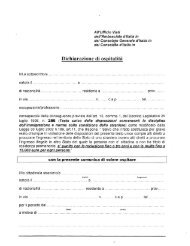<strong>Investment</strong> <strong>in</strong> <strong>Italy</strong>necessary <strong>in</strong>spections and issu<strong>in</strong>g f<strong>in</strong>es where appropriate. Its mission <strong>in</strong>cludes protect<strong>in</strong>gend customers, supervis<strong>in</strong>g the text of contracts, review<strong>in</strong>g claims, and verify<strong>in</strong>g the fairconduct of <strong>in</strong>surance companies.The Energy Authority was set up by Law no. 481/1995 <strong>in</strong> order to regulate and supervisethe electricity and gas markets. The Authority is empowered to:• fix maximum tariffs for services, <strong>in</strong> order to ensure certa<strong>in</strong>ty and transparency to thebenefit of end customers• def<strong>in</strong>e guidel<strong>in</strong>es for the production and supply of energy and gas, set quality standards,check compliance, and establish the refunds to be made to end customers whereapplicable• verify that said guidel<strong>in</strong>es are actually observed and impose penalties• verify that competition laws and regulations are observed by the companies operat<strong>in</strong>g<strong>in</strong> the electricity and gas markets, and <strong>in</strong>form the relevant authority <strong>in</strong> the event ofviolations• exam<strong>in</strong>e claims and petitions filed by end customers, promot<strong>in</strong>g settlements withoperators where appropriate or order<strong>in</strong>g operators to modify their service provision.3.2.2Securities offers and prospectus approvalIn l<strong>in</strong>e with EU directives, issuers offer<strong>in</strong>g securities must produce a prospectus <strong>in</strong> order toensure that <strong>in</strong>vestors receive all the relevant <strong>in</strong>formation. The prospectus must be approvedby Consob, the public authority responsible for regulat<strong>in</strong>g the Italian securities market; and the<strong>in</strong>formation provided <strong>in</strong> the prospectus must be complete, coherent and understandable. Onceapproved, the prospectus can also circulate <strong>in</strong> other EU Member States for local offer<strong>in</strong>g.The prospectus must conta<strong>in</strong> full details of the offer and <strong>in</strong>formation about the issuer,<strong>in</strong>clud<strong>in</strong>g corporate governance, any shareholders’ agreements, the key performance<strong>in</strong>dicators of the bus<strong>in</strong>ess and, <strong>in</strong> general, any factors, either <strong>in</strong>ternal or external to theissuer, which may have an impact on the terms of the offer.Specific rules are set for takeover bids for listed companies: if, as a result of acquisition, oneor more <strong>in</strong>vestors acquire over 30 percent of the capital, a takeover bid must be addressedto all the other shareholders for the purpose of acquir<strong>in</strong>g 100 percent of the capital. Thereare further rules if one or more <strong>in</strong>vestors own more that 90 percent of a listed company orown between 30 percent and 50 percent of the capital and <strong>in</strong>crease their <strong>in</strong>terest.There are squeeze-out rules for <strong>in</strong>vestors own<strong>in</strong>g over 98 percent of the share capital as aconsequence of a take-over bid.For more <strong>in</strong>formation, please contact:Sabr<strong>in</strong>a PugliesePartneremail: sabr<strong>in</strong>apugliese@kpmg.it30© 2012 KPMG S.p.A., KPMG Advisory S.p.A., KPMG Fides Servizi di Amm<strong>in</strong>istrazione S.p.A., KPMG Audit S.p.A., Italian limited liability share capital companies, and Studio Associato Consulenza legale e tributaria, anItalian professional partnership, are member firms of the KPMG network of <strong>in</strong>dependent member firms affiliated with KPMG International Cooperative (“KPMG International”), a Swiss entity. All rights reserved.
<strong>Investment</strong> <strong>in</strong> <strong>Italy</strong>4.Account<strong>in</strong>g and report<strong>in</strong>g4.1Legal framework and regulationsAccount<strong>in</strong>g and report<strong>in</strong>g are ma<strong>in</strong>ly regulated by the follow<strong>in</strong>g laws and regulations:• the Italian Civil Code• Italian Tax Codes• Italian Account<strong>in</strong>g Standards (local GAAP)• International Account<strong>in</strong>g Standards/International F<strong>in</strong>ancial Report<strong>in</strong>g Standards, whereapplicable.4.2RequirementsItalian bookkeep<strong>in</strong>g is based on double entries.Records must be made <strong>in</strong> chronologicalorder, without empty spaces or notes, and must not conta<strong>in</strong> deletions; only where strictlynecessary can text be crossed through <strong>in</strong> such a way that the letters rema<strong>in</strong> legible. Thegeneral ledger must report all transactions on a daily basis.As of January 2009 account<strong>in</strong>g books can also be kept on digital supports. Specificprovisions are <strong>in</strong> place to guarantee the true date of entries. All books and records, even ifcomputerised, must be kept for at least ten years after the date of the last entry, togetherwith all related bus<strong>in</strong>ess correspondence.4.3Compulsory bookkeep<strong>in</strong>g4.3.1The general ledgerAll the transactions performed by an Italian company must be recorded <strong>in</strong> this ledger <strong>in</strong> detailand <strong>in</strong> chronological order. Each entry must show the date of the transaction and <strong>in</strong>clude abrief description. All entries must be made with<strong>in</strong> 60 days of the relevant transactions.The general ledger must be consecutively numbered on each page, also show<strong>in</strong>g the fiscalyear (e.g. 2009/1, 2009/2, 2009/3,….). Stamp duty (currently EUR 14.62) is due at thebeg<strong>in</strong>n<strong>in</strong>g of each set of 100 pages.Local software is normally designed so that each entry <strong>in</strong> the general ledger is automaticallyrecorded <strong>in</strong> the VAT registers also.Amounts <strong>in</strong> foreign currency cannot be converted at an average monthly exchange rate,s<strong>in</strong>ce it is compulsory for tax and legal purposes to adopt the official exchange rate valid onthe date of the transaction.Accounts must be closed and reopened at the end of the f<strong>in</strong>ancial year. The general ledgermust be supported by ledger cards for each account (e.g. a ‘bank deposit account XXY’ledger card; a ‘cash 1’ account ledger card; a ‘client XYZ’ ledger card). All the transactionschronologically booked <strong>in</strong> the general ledger also have to be recorded <strong>in</strong> the ledger cards.© 2012 KPMG S.p.A., KPMG Advisory S.p.A., KPMG Fides Servizi di Amm<strong>in</strong>istrazione S.p.A., KPMG Audit S.p.A., Italian limited liability share capital companies, and Studio Associato Consulenza legale e tributaria, anItalian professional partnership, are member firms of the KPMG network of <strong>in</strong>dependent member firms affiliated with KPMG International Cooperative (“KPMG International”), a Swiss entity. All rights reserved.31
















